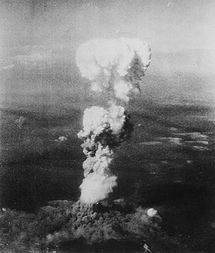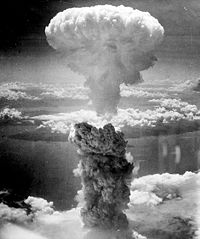1234567890
Facts And Figures
|
|
|
|
|
The mushroom cloud over Hiroshima after the dropping of Little Boy |
The Fat Man mushroom cloud resulting from the nuclear explosion over Nagasaki rises 18 km (11 mi, 60,000 ft) into the air from the hypocenter. |
The atomic bombings of Hiroshima and Nagasaki were nuclear attacks near the end of World War II against the Empire of Japan by the United States at the executive order of U.S. President Harry S. Truman on August 6 and 9, 1945. After six months of intense fire-bombing of 67 other Japanese cities, the nuclear weapon "Little Boy" was dropped on the city of Hiroshima on Monday,August 6, 1945,followed on August 9 by the detonation of the "Fat Man" nuclear bomb over Nagasaki. These are to date the only attacks with nuclear weapons in the history of warfare.
The bombs killed as many as 140,000 people in Hiroshima and 80,000 in Nagasaki by the end of 1945,roughly half on the days of the bombings. Since then, thousands more have died from injuries or illness attributed to exposure to radiation released by the bombs.In both cities, the overwhelming majority of the dead were civilians.
Six days after the detonation over Nagasaki, on August 15, Japan announced its surrender to the Allied Powers, signing the Instrument of Surrender on September 2, officially ending the Pacific War and therefore World War II. (Germany had signed its unavoidable Instrument of Surrender on May 7, ending the war in Europe.) The bombings led, in part, to post-war Japan adopting Three Non-Nuclear Principles, forbidding that nation from nuclear armament.
Hiroshima during World War II
At the time of its bombing, Hiroshima was a city of some industrial and military significance. A number of military camps were located nearby, including the headquarters of the Fifth Division and Field Marshal Shunroku Hata's 2nd General Army Headquarters, which commanded the defense of all of southern Japan. Hiroshima was a minor supply and logistics base for the Japanese military. The city was a communications center, a storage point, and an assembly area for troops. It was one of several Japanese cities left deliberately untouched by American bombing, allowing a pristine environment to measure the damage caused by the atomic bomb.
The center of the city contained several reinforced concrete buildings and lighter structures. Outside the center, the area was congested by a dense collection of small wooden workshops set among Japanese houses. A few larger industrial plants lay near the outskirts of the city. The houses were of wooden construction with tile roofs, and many of the industrial buildings also were of wood frame construction. The city as a whole was highly susceptible to fire damage.
The population of Hiroshima had reached a peak of over 381,000 earlier in the war, but prior to the atomic bombing the population had steadily decreased because of a systematic evacuation ordered by the Japanese government. At the time of the attack the population was approximately 255,000. This figure is based on the registered population used by the Japanese in computing ration quantities, and the estimates of additional workers and troops who were brought into the city may be inaccurate.
The Bombing
Hiroshima was the primary target of the first nuclear bombing mission on August 6, with Kokura and Nagasaki being alternative targets. August 6 was chosen because there had previously been cloud cover over the target. The 393d Bombardment Squadron B-29 Enola Gay, piloted and commanded by 509th Composite Group commander Colonel Paul Tibbets, was launched from North Field airbase on Tinian in the West Pacific, about six hours flight time from Japan. The Enola Gay (named after Colonel Tibbets' mother) was accompanied by two other B29s, The Great Artiste which carried instrumentation, commanded by Major Charles W. Sweeney, and a then-nameless aircraft later called Necessary Evil (the photography aircraft) commanded by Captain George Marquardt.
After leaving Tinian the aircraft made their way separately to Iwo Jima where they rendezvoused at 2,440 m (8,000 ft) and set course for Japan. The aircraft arrived over the target in clear visibility at 9,855 m (32,000 ft). On the journey, Navy Captain William Parsons had armed the bomb, which had been left unarmed to minimize the risks during takeoff. His assistant, 2nd Lt. Morris Jeppson, removed the safety devices thirty minutes before reaching the target area.
The release at 08:15 (Hiroshima time) was uneventful, and the gravity bomb known as "Little Boy", a gun-type fission weapon with 60 kg (130 pounds) of uranium-235, took fifty-seven seconds to fall from the aircraft to the predetermined detonation height about six hundred meters (1,900 ft) above the city. Due to crosswind, it missed the aiming point, the Aioi Bridge, by almost eight hundred feet and detonated directly over Shima Surgical Clinic. It created a blast equivalent to about 13 kilotons of TNT. (The U-235 weapon was considered very inefficient, with only 1.38% of its material fissioning.) The radius of total destruction was about one mile (1.6 km), with resulting fires across 11.4 km² (4.4 square miles).Infrastructure damage was estimated at ninety percent of Hiroshima's buildings being either damaged or completely destroyed.
About an hour before the bombing, Japanese early warning radar detected the approach of some American aircraft headed for the southern part of Japan. An alert was given and radio broadcasting stopped in many cities, among them Hiroshima. At nearly 08:00, the radar operator in Hiroshima determined that the number of planes coming in was very small—probably not more than three—and the air raid alert was lifted. To conserve fuel and aircraft, the Japanese had decided not to intercept small formations. The normal radio broadcast warning was given to the people that it might be advisable to go to air-raid shelters if B-29s were actually sighted, but no raid was expected beyond some sort of reconnaissance.
Post-attack casualties
According to most estimates, the immediate effects of the blast killed approximately 70,000 people in Hiroshima. Estimates of total deaths by the end of 1945 from burns, radiation and related disease, the effects of which were aggravated by lack of medical resources, range from 90,000 to 140,000. Some estimates state up to 200,000 had died by 1950, due to cancer and other long-term effects. From 1950 to 1990, roughly 9% of the cancer and leukemia deaths among bomb survivors was due to radiation from the bombs. At least eleven known prisoners of war died from the bombing.
Poisoning Emergency/ Information
-
Mon-Fri8am-10pm
-
Sat, Sun & Public Holiday8am - 5pm
-
Telephone04 6536 999
-
Telegram chat



